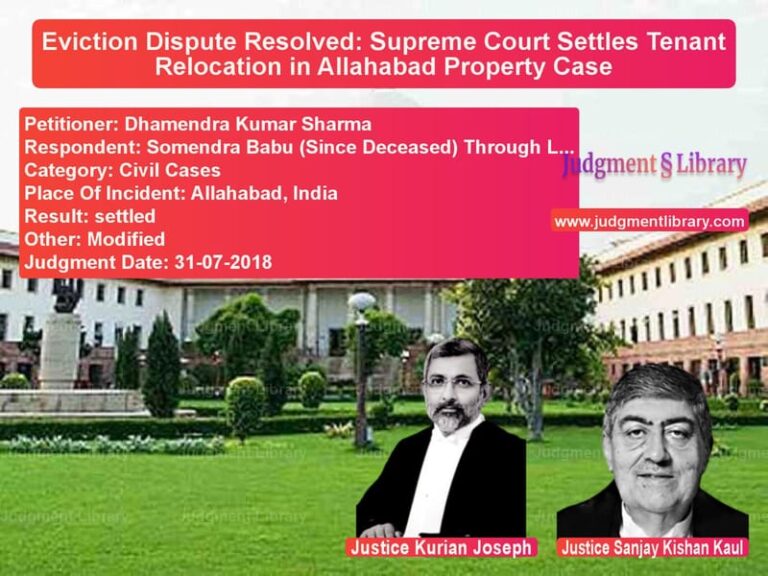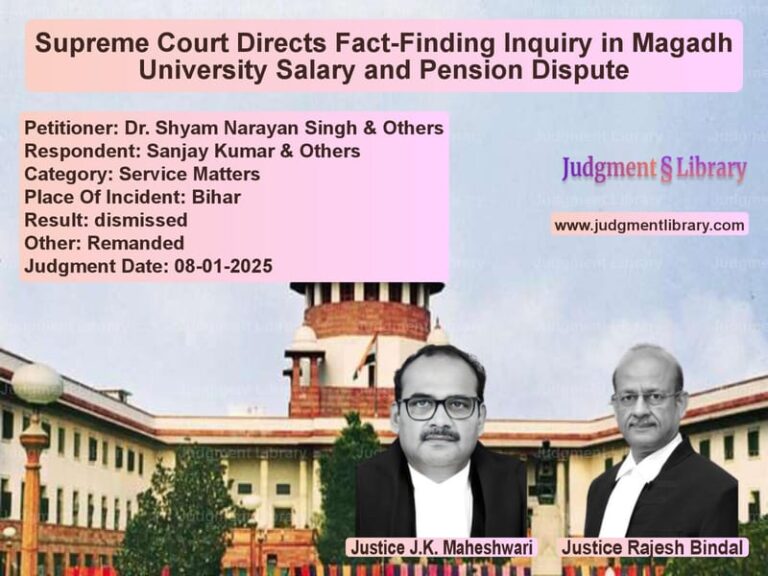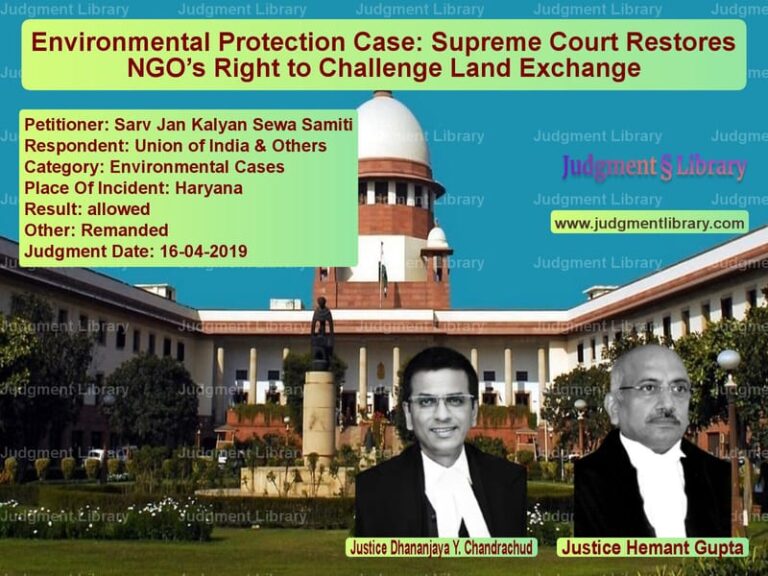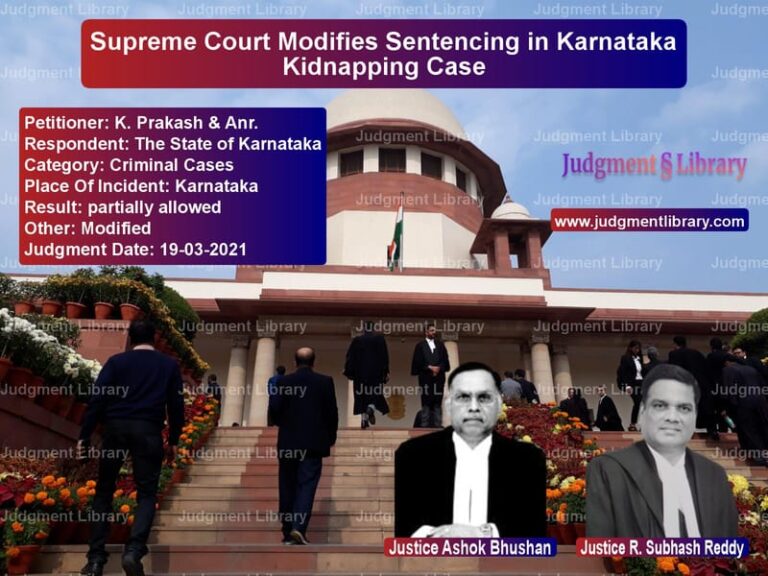Supreme Court Restores Compensation in Motor Accident Claim
In a significant ruling, the Supreme Court of India has reinstated the compensation awarded by the Motor Accident Claims Tribunal (MACT) to Rahul, the petitioner, after the High Court of Karnataka had reduced it. The case highlights the crucial role of judicial scrutiny in determining fair compensation in motor accident claims.
Background of the Case
The case arises from an unfortunate motor accident that occurred on January 27, 2013. Rahul, the appellant, was a pillion rider on a motorcycle bearing registration number KA-23/EC-6369 when the accident took place. The motorcycle was insured with the National Insurance Company Ltd., which became a respondent in the legal proceedings.
Rahul filed a claim petition before the Motor Accident Claims Tribunal (MAC No.1587 of 2013) at Raibag, Karnataka, seeking a compensation of Rs. 20,00,000 for the injuries he sustained. The Tribunal, after considering oral and documentary evidence, awarded him a compensation of Rs. 5,38,872 along with interest at 6% per annum. The compensation was calculated based on a 25% disability assessment.
Aggrieved by the Tribunal’s award, the insurance company filed an appeal (MFA No.103118 of 2014) before the High Court of Karnataka, arguing that the disability percentage was too high and that the compensation amount needed to be reduced. The High Court, after reassessing the case, reduced the disability percentage to 20% and consequently reduced the compensation to Rs. 4,74,072.
Rahul, dissatisfied with the High Court’s decision, challenged the ruling before the Supreme Court of India.
Petitioner’s Arguments
Rahul’s counsel argued that the High Court’s reduction of the disability percentage was arbitrary and not supported by medical evidence. He presented medical records, including Exs. P56 to P60, which documented the nature and extent of injuries sustained by Rahul.
The petitioner’s counsel emphasized the following points:
- Rahul suffered three major fractures: a fracture of the right radius, a fracture of the left radius, and a fracture of the styloid process of the ulna.
- He had undergone surgery where plates and screws were implanted in both his hands.
- Dr. N.Y. Joshi, who examined Rahul, issued a disability certificate (Ex.P57) stating that Rahul had suffered a 50% disability.
- The Tribunal had already taken a conservative approach by fixing the disability percentage at 25% instead of the full 50% mentioned in the medical certificate.
- Rahul, being an agriculturist, was severely impacted by his injuries, making it difficult for him to carry out his profession.
The counsel contended that the High Court erred in reducing the disability percentage further to 20% without examining Dr. Joshi or considering the full medical evidence.
Respondent’s Arguments
The insurance company defended the High Court’s decision, arguing that the reduced compensation was just and appropriate under the circumstances. The counsel for the insurance company presented the following arguments:
- The High Court had appropriately reassessed the compensation and reduced it after considering the available evidence.
- The Tribunal’s calculation of disability at 25% was excessive, given that the doctor who issued the certificate was not examined before the Tribunal.
- The awarded compensation sufficiently covered the petitioner’s medical expenses, loss of future earnings, and other damages.
- There was no substantial evidence to support the claim that Rahul’s earning capacity was significantly diminished.
Supreme Court’s Observations
The Supreme Court carefully examined the evidence presented by both parties and made the following observations:
- The fact of the accident was undisputed, and the motorcycle involved was insured with the insurance company.
- The medical records (Ex.P56 to Ex.P60) clearly showed that Rahul had suffered multiple fractures and had undergone surgical procedures with permanent implants.
- The disability certificate issued by Dr. Joshi assessed Rahul’s permanent disability at 50%, yet the Tribunal had conservatively reduced it to 25%.
- The High Court did not provide sufficient reasoning for further reducing the disability percentage to 20%.
The Supreme Court held that the High Court had erred in reassessing the disability percentage and reducing the compensation. The judgment stated:
“The reduction of compensation was not required, particularly when there is no basis in support thereof. The Tribunal had already made a fair assessment by fixing the disability at 25%.”
Final Judgment
In its ruling, the Supreme Court set aside the High Court’s decision and reinstated the Tribunal’s judgment. The Court directed the insurance company to:
- Deposit the full compensation amount of Rs. 5,38,872 as originally awarded by the Tribunal.
- Ensure that the compensation is deposited along with interest as determined by the Tribunal.
- Make the payment within four weeks from the date of receipt of the judgment.
Furthermore, the Court allowed Rahul to withdraw the compensation amount once deposited.
Conclusion
This judgment underscores the importance of ensuring fair compensation for accident victims. It also highlights the necessity for courts to rely on medical evidence and expert testimony when determining disability percentages. The Supreme Court’s intervention in this case ensures that the petitioner receives appropriate compensation for his injuries and loss of future earnings.
Accident victims often face immense financial and physical hardships, and the role of the judiciary in protecting their rights is crucial. The ruling serves as a precedent for similar cases where disability assessments impact compensation calculations.
By restoring the original compensation awarded by the Tribunal, the Supreme Court has reaffirmed the principle that courts must adopt a fair and just approach while dealing with personal injury claims.
Petitioner Name: Rahul.Respondent Name: National Insurance Company Ltd..Judgment By: Justice Sudhanshu Dhulia, Justice R. Mahadevan.Place Of Incident: Raibag, Karnataka.Judgment Date: 09-08-2024.
Don’t miss out on the full details! Download the complete judgment in PDF format below and gain valuable insights instantly!
Download Judgment: rahul-vs-national-insurance-c-supreme-court-of-india-judgment-dated-09-08-2024.pdf
Directly Download Judgment: Directly download this Judgment
See all petitions in Compensation Disputes
See all petitions in Motor Vehicle Act
See all petitions in Negligence Claims
See all petitions in Judgment by Sudhanshu Dhulia
See all petitions in Judgment by R. Mahadevan
See all petitions in allowed
See all petitions in supreme court of India judgments August 2024
See all petitions in 2024 judgments
See all posts in Accident Cases Category
See all allowed petitions in Accident Cases Category
See all Dismissed petitions in Accident Cases Category
See all partially allowed petitions in Accident Cases Category







